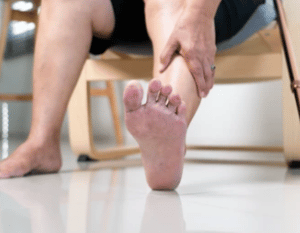A Guide to Diabetic Foot Care

A Guide to Diabetic Foot Care
Diabetes can be very dangerous – but did you know the complications of diabetes can be especially dangerous to your feet? Diabetes can reduce blood flow to the feet, making injuries that may seem simple turn into much larger problems. Patients with diabetes are at a higher risk for peripheral arterial disease, peripheral vascular disease in the lower extremities, peripheral neuropathy (tingling, numbness, or burning in the feet/legs), delayed wound healing, development of foot ulcers, thickened fungal toenails, and the potential for amputation. Because of these higher risks, it is important that people with type 1 or type 2 diabetes are on top of their daily foot care.
This starts at home, but also includes working with a doctor to keep your foot care maintenance on track, so you are healthy and safe. Here are some general diabetic foot care guidelines that we recommend you follow to help avoid foot complications.
Daily Foot Inspection
It’s recommended that patients with diabetes conduct daily foot inspections on their own. During this inspection, we recommend that these patients check for cuts, blisters, redness, swelling, or nail problems. If you have an issue seeing all parts of your feet from your position, we recommend using a hand mirror.
This way, you can make sure that you are thoroughly inspecting your feet, so nothing slips past you and ends up causing problems later down the line. It is also important to keep up with your podiatric hygiene by keeping your feet clean, so your skin isn’t too dry or causing you any issues.
Washing Your Feet
Obviously, this isn’t something we have to tell you to do, since most people already do this on a daily basis. Though, we do have some tips and tricks for washing your feet that can really benefit you and become a vital part of your daily foot care guidelines. When washing your feet, we recommend that you use lukewarm water instead of hot, much like the water you would use on a newborn baby. We also recommend that you wash your feet very gently, like using a soft washcloth or sponge. When it comes to drying off, do not rub your feet, but instead pat them dry.
Moisturize Your Feet
It is very important to keep your skin moisturized, especially the skin on your feet. You do not want your skin to get too dry and crack, which could lead to a myriad of issues. Instead, we recommend that you moisturize your feet after you wash them by applying lotion or petroleum jelly to your feet. Though, do not moisturize between your toes. Moisturizing between your toes can lead to fungal infections, which needs to be avoided. In order to prevent cracking from your feet being cold, we recommend you often wear socks, particularly when you go to bed.
Protect Your Feet from The Cold
As mentioned, beyond moisturizing, it is important to protect your feet from the cold. Since the blood flow to your feet is reduced by diabetes, your feet can become cold easily. To prevent this, we recommend that you often wear socks, most particularly, that you wear socks to bed. Make sure the socks you are wearing are dry and soft, and that you are changing your socks regularly. Although keeping your feet warm is important, we still do not recommend using hot water on your feet or ever applying a heating pad to your feet.
Protect Your Feet from The Heat
Your feet will most often become cold than become hot, but there are some important steps in protecting your feet from the heat. If you have any nerve damage that has been caused by your diabetes, you can actually burn your feet without even feeling it. This is why we recommend ALWAYS wearing shoes, whether you are at home or out and about. Especially at the beach, wear shoes to protect your feet from the hot sand. You can even put sunscreen on the top of your feet to protect them from sunburn.
Proper Footwear
One of the most important steps in a diabetic’s foot care guideline is to make sure you are always wearing proper footwear. There is not one specific type of shoe we recommend, but there are some general guidelines you should always follow. Make sure your shoes fit properly and are not too loose and not too snug. We often recommend that you wear shoes with closed toes and heels, a stiff outer sole, and a cushioned inner sole. We also recommend that you look into wearing diabetic-specific socks, which are made specifically to improve blood flow, keep your feet dry, prevent fungal infections, and provide a cushion.
Treat Yourself to A Professional “Pedicure” – Regularly
While we don’t recommend going to get a pedicure at a salon, we highly recommend that you keep up on the hygiene of your feet by visiting your Podiatrist on a regular basis. You should not cut your own toenails or file down your calluses, as even a small cut to the skin can end up leading to big problems such as diabetic foot ulcers and infection. We recommend that you see your trusted Podiatrist every 3-4 months for routine nail care.
Treat Minor Problems Immediately
Whether it is a cut, bump, sore, or burn, you need to take action fast. Always report your foot injuries to your doctor as soon as they become aware to you. Self-treating foot problems is not recommended, as even the smallest of injuries can lead to bigger problems. Call your doctor right away, and they can walk you through the best treatment methods, or they might have you come in for further treatment as needed. While something like this might seem small, minor problems can make major impacts on your health and should be taken very seriously.
Keep In Contact with Your Doctor
Having a trusted podiatrist on your side is so important, especially for patients with diabetes. You never want to find yourself in a situation in which you have questions and nowhere to get your answers. As mentioned, self-treatment is not the most reliable method when it comes to diabetic foot care, so you should have a doctor that you trust. Whenever needed, you can contact your doctor to ask questions, to report any problems, and to update them on your general foot health.
Nilin M. Rao, DPM, Ph.D., FACFAS, is a double board-certified, fellowship-trained foot and ankle surgeon and podiatrist who specializes in all aspects of foot and ankle care, including diabetic foot care. To schedule an appointment with Dr. Rao, please call (602) 734-1834.
